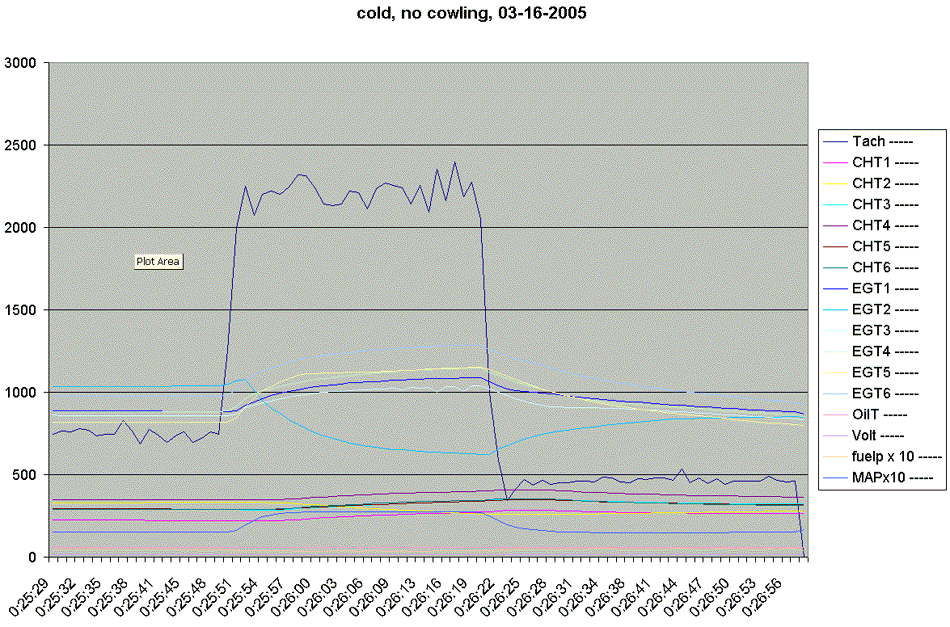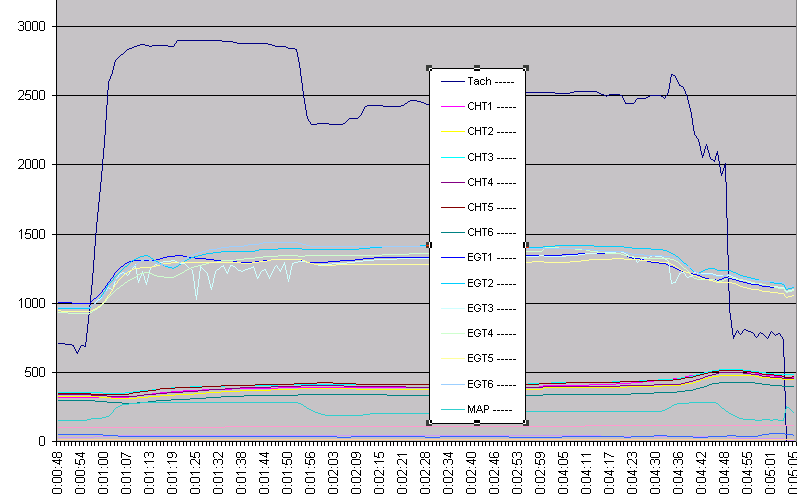Mark Langford's KR2S Covair Project
First Engine Runs (2)
created April 1, 2005

I now know what it takes to melt a Corvair head. Well, not really melt, but yield to the point of failure. I'm here to answer that question with actual experience. 570F degrees measured at the plug boss will do the job! I was having a strange problem with engine roughness that turned out to be a bad spark plug that just quit at anything over 1100 rpm or so. Notice how EGT number 2 takes a nose dive shortly after the throttle is advanced, and comes back to life as the throttle is returned to idle. In the process of troubleshooting that problem, I ran it for an extended period at full throttle, which turns out to have been a dumb idea. I had set my EIS to issue a warning at 550F, going on the information that the stock GM idiot light comes on at that temp. It turns out from further investigation that the head was actually seeing 570 degrees, which I discovered by measuring the temp at the stock location and compared it to the spark plug CHT reading. I get all this information from the EIS, which will plot out all outputs to a laptop (see EIS runs).
A differential compression test yielded air blowing out around the head gasket, so I pulled it apart (takes about 20 minutes) and discovered that #4 (always the hottest CHT, as you can see in the plot above) had a ridge sunk into it, in a scalloped pattern ranging from .003" to .007". So the head needed to be resurfaced. It occured to me that my local VW emporium was quite familiar with opening up VW heads to 94mm, so I carried it down there for to be resurfaced. A compression check on the passenger bank showed no problems, but I took that head off too, and sure enough, no hint of a ridge on the bank that stays the coolest. It runs cooler by virtue of having the propwash swept into the intake, whereas the pilot's side is somewhat deprived when running on the ground. This is the downside of the plenum setup that I'm using, rather than the fully open setup that everybody else is running. At speed and altitude though, cooling should be quite sufficient. Even on the ground I can maintain CHTs level at 415 running about 2550 rpm, so that'll get me there. The fact that it can stand up to 550F is pretty amazing to me.
Not having had any problems with detonation so far, I figure I might as well raise my compression from 8.4:1 to 9:1, so I'll go from .060" copper head gaskets on both sides to .040" on the side that needed .008" of "cleaning up", and .032 on the other. This gets me back to equal chamber volumes between left and right banks. Not really a big deal, but I sure was ready for suicide the night I discovered the problem! I even went so far as to drag out my spare 95 hp RH engine and start thinking about startin' over from scratch!
But total time to recover from this mess was maybe five hours of actual work, which included removing and replacing both heads. I've also taken the opportunity to build a spare head, bored out to 94mm. But this time, rather than welding the intake tube to the head, I will flange the tube and bolt it to the manifold so the head can be used for either left or right side by merely flipping the intake tube around 180 degrees, and with zero increase in the height of the tube. I machined off the GM carb flange flat, match-drilled the mating flange, and will tap the manifold for 5/16" bolts.
Since this excercise, I've tested a stock GM head temp sensor switch, and it closes at about 520 degrees, as measured by my digital Fluke thermometer. I'll hook up an ultra-bright LED to it to keep me from being that stupid again. That is plenty of headroom, considering actual damage doesn't occur until you approach 550 degrees.

Here's another run. See the squiggly light blue EGT3 line? That's the valve sticking to the guide whenever the throttle is advanced enough for things to heat up. I knew it when I saw this run, and disassembly proved it. Since I had the heads off and apart, I went ahead and opened up the guide clearance on all the guides from .001" clearance to .002" clearance, so I feel sure that'll be the end of that. I probably wouldn't have had the problem had my CHTs climbed so high, but just to be safe, I opened them up a bit more. Tach readings in the plot above were inaccurate, but that's been fixed now with the 27k ohm resistor on the tach input lead, and setting the EIS back to P/R=3.
The head has not been resurfaced yet, but that's expected to be done later this week, and the engine should be running shortly thereafter. One thing I'm going to do is add a flow director to try to keep number 4 a little cooler, in line with the others. Right now I'm working on some of those other details, such as adding a carb temp sensor, an idiot light (ultra bright LED) connected to the stock GM head temp sensor, and yesterday I finished installing shoulder belts. I also moved my control cables to the panel from the temporary bracket that I had hanging from below. And I believe I have put my aft deck on for the last time before I fly, since the shoulder belts are finished.
Setting up the new spare head I used a Neway cutter to redo the seats. There are more details on that on my Valve Job page.
I realize that there are those who think I'm never actually going to fly this thing...that maybe I'm just going to goof around with it for the rest of my life. Maybe so, but I still enjoy tinkering with it. Taking the heads off gave me the opportunity to look around in there and see how everything was doing (even with only 6 hours on it), and all looks to be well. One interesting thing I noticed is that the two rear cylinders (#1 and #2) are definitely running richer than the other four, which I attribute to liquid fuel that makes it's way into the intake log running "downhill" to those cylinders, since the plane is sitting on it's tail. I'll bet this phenomenon goes away once I'm flying. You can see in the plot above how number 1 and number 2 are the coolest cylinders, and suspect this richness is a contributing factor.
For more info on this engine, see my Corvair engine website.
Return to Mark Langford's KR2S

